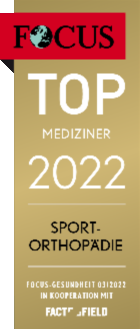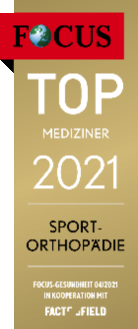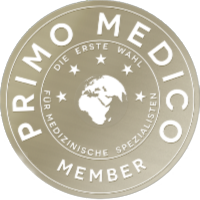Nonostante io sia nato e cresciuto a Monaco di Baviera ho iniziato i miei studi di medicina a Colonia. Dopodiché, passando da Würzburg, sono tornato nella mia città natale dove ho terminato i miei studi.
Ho iniziato il percorso di formazione di sei anni come specialista in ortopedia e chirurgia traumatologica presso il dipartimento di ortopedia, medicina fisica e riabilitazione presso il campus di Großhadern della LMU. Durante questo periodo sono stato spostato per due anni nella clinica Helios di Monaco-Perlach. Lì si è svolta la mia formazione in chirurgia traumatologica e sono stato in servizio come medico di emergenza a Monaco di Baviera.



Prof. Dr. med. Andreas Ficklscherer
VITA
Infine, nel 2013, ho completato la mia formazione come specialista in chirurgia ortopedica e traumatologica.
Già all´inizio della mia formazione ho voluto specializzarmi su tutti gli aspetti della chirurgia delle ginocchia e della spalla. Questo profondo interesse si riflette anche nel mio lavoro scientifico come lo dimostrano le numerose pubblicazioni in materia, il mio lavoro post-dottorato riguardo alla rigenerazione del tendine della spalla e le borse di studio della ESSKA (società europea di traumatologia dello sport, chirurgia del ginocchio e artroplastica) e della AGA (società di artroscopia e chirurgia comune).
Studium
Universität zu Köln
Julius-Maximilians-Universität Würzburg
Ludwig-Maximilians-Universität München
Stationen der Facharztausbildung
Klinik und Poliklinik der LMU München – Campus Großhadern
(Prof. Dr. med. V. Jansson)
Helios Klinik München-Perlach; Klinik für Unfallchirurgie und Orthopädie
(Prof. Dr. med. H.J. Andreß)
Promotion
Endoprothetik am oberen Sprunggelenk – Evaluation der tibialen Verankerung. Experimentelle Studie am Labor für Biomechanik und experimentelle Orthopädie der LMU München (Prof. Dr. med. habil. Dr.-Ing. Plitz, 2009)
Habilitation
Einflussfaktoren auf die knöcherne Sehnenintegration nach Rotatorenmanschettenrekonstruktion (Prof. Dr. med. Dipl.-Ing. V. Jansson, 2014).
Bestellung zum Professor an der Ludwig-Maximilians- Universität München (July 2021).
Mitgliedschaften
Deutsche Gesellschaft für Orthopädie und Unfallchirurgie (DGOU)
Arbeitsgemeinschaft Geweberegeneration der DGOU
Deutsche Gesellschaft für Orthopädie und orthopädische Chirurgie (DGOOC)
Gesellschaft für Arthroskopie und Gelenkchirurgie (AGA)
Deutsche Vereinigung für Schulter- und Ellenbogenchirurgie (DVSE)
European Society of Sports Traumatology, Knee Surgery and Arthroscopy (ESSKA)
Deutsche Gesellschaft für Berg- und Expeditionsmedizin e.V. (BexMed)
Fellowships
European Arthroscopy Fellowship 2012 der Gesellschaft für Arthroskopie und Gelenkchirurgie – AGA
International Arthroscopy Fellowship 2017 der European Society of Sports Traumatology, Knee Surgery and Arthroscopy
Forschungspreis
Forschungsförderung der Friedrich-Baur-Stiftung München
Förderprogramm für Forschung und Lehre der Ludwig-Maximilians-Universität München
Perthes Preis 2013 der Deutschen Gesellschaft für Schulter- und Ellenbogenchirurgie für die Arbeit „Selective Paralysis of the Supraspinatus Muscle with Botulinumtoxin A in Rotator Cuff Repair in Rats.“
Spezielle Qualifikationen
DEGUM Zertifikat-Sonographie des Bewegungsapparates
Fachkunde Strahlenschutz, Röntgendiagnostik des gesamten Skeletts einschl. Notfalldiagnostik
Fachkunde Arzt im Rettungsdienst
Zusatzbezeichnung Manuelle Medizin / Chirotherapie
Psychosomatische Grundausbildung
Zertifikat der Deutschen Gesellschaft für ästhetische Botulinomtoxin-Therapie
Mentor im MeCuM-Mentor-Programm für Studierende
Reviewer für mehrere internationale Journals
Persönliches
Verheiratet, 3 Kinder
Hobbys: Laufen (Marathon), Skifahren, Skitouren, Mountainbiken
PUBBLICAZIONI
Bücher und Buchbeiträge
1 – BASICS Orthopädie und Traumatologie, 1.-5. Auflage,
A. Ficklscherer, Elsevier GmbH, ISBN 978-3437422102
2 – Mediscript StaR, 1. Auflage, Kapitel „Orthopädie und Unfallchirurgie“,
A. Ficklscherer, Elsevier GmbH, ISBN 978-3437435553
3 – Pflegen | Gesundheits- und Krankheitslehre, 1. Auflage, Kapitel 14 „Erkrankungen des Bewegungsapparats”,
A. Ficklscherer, Elsevier GmbH, ISBN 978-3437254048
4 – Kurzlehrbuch Orthopädie und Unfallchirurgie, 1. Auflage,
A. Ficklscherer und S. Weidert, Elsevier GmbH, ISBN 978-3437433351
5 – MEX | Das Mündliche Examen Orthopädie und Unfallchirurgie, 1. Auflage, 2018,
A. Ficklscherer und A. Paulus, Elsevier GmbH, ISBN: 978-3-437-41851-8
Originalarbeiten
1 – Pullout strength of suture anchors in comparison with transosseous sutures for rotator cuff repair.
Pietschmann MF, Fröhlich V, Ficklscherer A, Hausdorf J, Utzschneider S, Jansson V, Müller PE. Knee Surg Sports Traumatol Arthrosc. 2008 May;16(5):504-10.
2 – Biomechanical testing of a new knotless suture anchor compared with established anchors for rotator cuff repair.
Pietschmann MF, Froehlich V, Ficklscherer A, Wegener B, Jansson V, Müller PE. J Shoulder Elbow Surg. 2008 Jul-Aug;17(4):642-6.
3 – Suture anchor fixation strength in osteopenic versus non-osteopenic bone for rotator cuff repair.
Pietschmann MF, Fröhlich V, Ficklscherer A, Gülecyüz MF, Wegener B, Jansson V, Müller PE. Arch Orthop Trauma Surg. 2009 Mar;129(3):373-9.
4 – Toothpick injury simulating a pigmented villonodular synovialitis.
Wegener B, Ficklscherer A, Müller PE, Baur-Melnyk A, Jansson V, Dürr HR. J Pediatr Surg. 2009 Feb;44(2):e29-32.
5 – Navigation in minimally invasive unicompartmental knee arthroplasty has no advantage in comparison to a conventional minimally invasive implantation.
Weber P, Utzschneider S, Sadoghi P, Pietschmann MF, Ficklscherer A, Jansson V, Müller PE. Arch Orthop Trauma Surg. 2012 Feb;132(2):281-8.
6 – Lunar phase does not influence perioperative complications in total hip arthroplasty.
Ficklscherer A, Angermann A, Weber P, Wegener B, Pietschmann MF, Müller PE
Arch Med Sci 2012; 8, 1: 111-114.
7 – Sports activities after medial unicompartmental knee arthroplasty Oxford III-what can we expect?
Pietschmann MF, Wohlleb L, Weber P, Schmidutz F, Ficklscherer A, Gülecyüz MF, Safi E, Niethammer TR, Jansson V, Müller PE. Int Orthop. 2013 Jan;37(1):31-7.
8 – Effects of selective paralysis of the supraspinatus muscle using
botulinum neurotoxin A in rotator cuff healing in rats.
Ficklscherer A, Hartl TK, Scharf M, Sievers B, Schröder C, Milz S, Niethammer T, Pietschmann MF, Müller PE. J Orthop Res. 2013 May;31(5):716-23.
9 – Graft hypertrophy of matrix-based autologous chondrocyte implantation: a two-year follow-up study of NOVOCART 3D implantation in the knee.
Niethammer TR, Pietschmann MF, Horng A, Roßbach BP, Ficklscherer A, Jansson V, Müller PE. Knee Surg Sports Traumatol Arthrosc. 2014 Jun;22(6):1329-36.
10 – Thermoelastic stress analysis to validate tibial fixation technique in total ankle prostheses – a pilot study.
Ficklscherer A, Wegener B, Niethammer T, Pietschmann MF, Müller PE, Jansson V, Trouillier HH. Ulus Travma Acil Cerrahi Derg. 2013 Mar;19(2):98-102.
11 – Early resumption of physical activities leads ti inferior clinical outcomes after matrix-based autologous chondrocyte implantation in the knee.
Niethammer TR, Müller PE, Safi E, Ficklscherer A, Roßbach BP, Jansson V, Pietschmann MF. Knee Surg Sports Traumatol Arthrosc. 2014 Jun;22(6):1345-52.
12 – Comparison of ropivacaine and fentanyl toxicity in human fibroblasts.
Andreas Ficklscherer, Birte Sievers, Julia Redeker, Mehmet F. Gülecyüz, Alexander Paulus, Matthias F. Pietschmann, Peter E. Müller. Arch Med Sci 2013; 9, 3: 576-580.
13 – Fentanyl is less toxic on adult human mesenchymal stem cells compared to ropivacaine when used intraarticularly. A controlled in vitro study.
Ficklscherer A, Kreuz PC, Sievers B, Gülecyüz MF, Jansson V, Müller PE. Connect Tissue Res. 2013;54(6):403-7.
14 – Polyethylene wear particles induce TLR 2 upregulation in the synovial layer of mice.
Paulus AC, Frenzl J, Ficklscherer A, Rossbach BP, Melcher C, Jansson V, Utzschneider S. J Mater Sci Mater Med. 2014 Feb;25(2):507-13.
15 – Tissue characteristics in tendon-to-bone healing change after rotator cuff repair using botulinumneurotoxin A for temporary paralysis of the supraspinatus muscle in rats.
Ficklscherer A, Scharf M, Hartl TK, Schröder C, Milz S, Roßbach BP, Gülecyüz MF, Pietschmann MF, Müller PE. Connect Tissue Res. 2014 Apr;55(2):140-6.
16 – Does footprint preparation influence tendon-to-bone healing after rotator cuff repair in an animal model?
Ficklscherer A, Loitsch T, Serr M, Gülecyüz MF, Niethammer TR, Müller HH, Milz S, Pietschmann MF, Müller PE. Arthroscopy. 2014 Feb;30(2):188-94.
17 – Graft Maturation of Autologous Chondrocyte Implantation: Magnetic Resonance Investigation With T2 Mapping.
Niethammer TR, Safi E, Ficklscherer A, Horng A, Feist M, Feist-Pagenstert I, Jansson V, Pietschmann MF, Müller PE. Am J Sports Med. 2014 Sep;42(9):2199-204.
18 – UKA can Be Safely Revised to Primary Knee Arthroplasty by Using an Autologous Bone Plate From the Proximal Lateral Tibia.
Pietschmann MF, Ficklscherer A, Wohlleb L, Schmidutz F, Jansson V, Müller PE. J Arthroplasty. 2014 Oct;29(10):1991-5.
19 – Primary synovial chondromatosis of the hip – is arthroscopy sufficient? A review of the literature and a case report.
Duif C, von Schulze Pellengahr C, Ali A, Hagen M, Ficklscherer A, Stricker I, Lahner M. Technol Health Care. 2014;22(5):667-75.
20 – The long head of the biceps tendon is a suitable cell source for tendon tissue regeneration.
Pietschmann MF, Wagenhäuser MU, Gülecyüz MF, Ficklscherer A, Jansson V, Müller PE. Arch Med Sci. 2014 Jun 29;10(3):587-96.
21 – Prevalence of femoro-acetabular impingement in international competitive track and field athletes.
Lahner M, Bader S, Walter PA, Duif C, von Schulze Pellengahr C, Lukas C, Ficklscherer A, Fickert S, Hagen M. Int Orthop. 2014 Dec;38(12):2571-6.
22 – Arthroscopic fixation of cell free polymer-based cartilage implants with a bioinspired polymer surface on the hip joint: a cadaveric pilot study.
Lahner M, Duif C, Ficklscherer A, Kaps C, Kalwa L, Seidl T. Biomed Res Int. 2014;2014:717912.
23 – Paving the way for future research in autologous chondrocyte implantation: response.
Niethammer TR, Safi E, Ficklscherer A, Horng A, Feist M, Feist-Pagenstert I, Jansson V, Pietschmann MF, Müller PE. Am J Sports Med. 2014 Nov;42(11).
24 – Is the Kinect system suitable for evaluation of the hip joint range of motion and as a screening tool for femoroacetabular impingement (FAI)?
Lahner M, Mußhoff D, von Schulze Pellengahr C, Willburger R, Hagen M, Ficklscherer A, von Engelhardt LV, Ackermann O, Lahner N, Vetter G. Technol Health Care. 2015;23(1):75-81.
25 – Biomechanical study of plantar pressures during walking in male soccer players with increased vs. normal hip alpha angles.
Hagen M, Abraham C, Ficklscherer A, Lahner M. Technol Health Care. 2015;23(1):93-100.
26 – Indications requiring preoperative magnetic resonance imaging before knee arthroscopy.
Roßbach BP, Pietschmann MF, Gülecyüz MF, Niethammer TR, Ficklscherer A, Wild S, Jansson V, Müller PE. Arch Med Sci. 2014 Dec 22;10(6):1147-52.
27 – Influence of Temperature on the Biomechanical Stability of Titanium, PEEK, Poly-L-Lactic Acid, and β-Tricalcium Phosphate Poly-L-Lactic Acid Suture Anchors Tested on Human Humeri In Vitro in a Wet Environment.
Güleçyüz MF, Mazur A, Schröder C, Braun C, Ficklscherer A, Roßbach BP, Müller PE, Pietschmann MF. Arthroscopy. 2015 Jun;31(6):1134-41
28 – Bone Marrow Edema in the Knee and Its Influence on Clinical Outcome After Matrix-Based Autologous Chondrocyte Implantation: Results After 3-Year Follow-up.
Niethammer TR, Valentin S, Gülecyüz MF, Roßbach BP, Ficklscherer A, Pietschmann MF, Müller PE. Am J Sports Med. 2015 May;43(5):1172-9.
29 – Revision surgery after third generation autologous chondrocyte implantation in the knee.
Niethammer T, Valentin S, Ficklscherer A, Gülecyüz M, Pietschmann M, Müller PE. Int Orthop. 2015 Aug;39(8):1615-22.
30 – Erratum to: Revision surgery after third generation autologous chondrocyte implantation in the knee.
Niethammer T, Valentin S, Ficklscherer A, Gülecyüz M, Pietschmann M, Müller PE. Int Orthop. 2015 Sep;39(9):1883.
31 – Primary stability of rotator cuff repair: can more suture materials yield more strength?
Gülecyüz M, Bortolotti H, Pietschmann M, Ficklscherer A, Niethammer T, Roßbach B, Müller PE. Int Orthop. 2016 May;40(5):989-97.
32 – Spinal cord damage after resection of destructive spinal lipoma resembling liposarcoma: case report.
Ficklscherer A, Zhang AZ, Baur-Melnyk A, Knösel T, Jansson V, Dürr HR.
Spinal Cord Ser Cases. 2016 Jul 7;2:16011.
33 – Clinical management of rotator cuff tears : Current concepts in cell-based therapy strategies.
Ficklscherer A, Pietschmann MF, Bendiks M, Roßbach BP, Müller PE.
Orthopade. 2016 Feb;45(2):143-8.
34 – Importance of a distal centralizer in experimental malpositioning of cemented stems. A biomechanical study on human femora.
Kusserow A, Ficklscherer A, Kreuz PC, Finze S, Mittelmeier W, Jansson V, Milz S, Wegener B. Arch Med Sci. 2015 Dec 10;11(6):1324-9.
35 – Incomplete defect filling after third generation autologous chondrocyte implantation.
Niethammer TR, Pietschmann MF, Ficklscherer A, Gülecyüz MF, Hammerschmid F, Müller PE. Arch Med Sci. 2016 Aug 1;12(4):785-92.
36 – Testing the feasibility and safety of the Nintendo Wii gaming console in orthopedic rehabilitation : a pilot randomized controlled study.
Ficklscherer A, Stapf J, Meissner KM, Niethammer T, Lahner M, Wagenhäuser M, Müller PE, Pietschmann MF. Arch Med Sci. 2016 Dec 1;12(6):1273-1278.
37 – Cell toxicity in fibroblasts, tenocytes, and human mesenchymal stem cells – a comparison of necrosis and apoptosis-inducing ability in ropivacaine, bupivacaine, and triamcinolone.
Zhang AZ, Ficklscherer A, Gülecyüz MF, Paulus AC, Niethammer TR, Jansson V, Müller PE. Arthroscopy. 2017 Apr;33(4):840-848
38 – The influence of different footprint preparation techniques on tissue regeneration in rotator cuff repair in an animal model.
Ficklscherer A, Serr M, Loitsch T, Niethammer TR, Lahner M, Pietschmann MF, Müller PE. Arch Med Sci. 2017 Mar 1;13(2):481-488.
39 – Novel ultrasound assisted suture anchor system using the BoneWelding® technology yields a comparable primary stability in osteopenic and healthy human humeri as a benchmark anchor.
Güleçyüz MF, Schröder C, Pietschmann MF, Göbel S, Lehmann M, Mayer J, Ficklscherer A, Jansson V, Müller PE. Acta Orthop Traumatol Turc. 2017 Dec 28. pii: S1017-995X(17)30066-4.
40 – The Primary Stability of a Bioabsorbable Poly-L-Lactic Acid Suture Anchor for Rotator Cuff Repair Is Not Improved with Polymethylmethacrylate or Bioabsorbable Bone Cement Augmentation.
Güleçyüz MF, Kraus-Petersen M, Schröder C, Ficklscherer A, Wagenhäuser MU, Braun C, Müller PE, Pietschmann MF. HSS J. 2018 Feb;14(1):15-22.
41 – Migration of Mesenchymal Stem Cells of Bursal Tissue after Rotator Cuff Repair in Rats.
Safi E, Ficklscherer A, Bondarava M, Betz O, Zhang A, Jansson V, Müller PE. Joints. 2018 Mar 13;6(1):4-9. doi: 10.1055/s-0038-1636948. eCollection 2018 Mar.
42 – Allogenic Myocytes and Mesenchymal Stem Cells Partially Improve Fatty Rotator Cuff Degeneration in a Rat Model.
Güleçyüz MF, Macha K, Pietschmann MF, Ficklscherer A, Sievers B, Roßbach BP, Jansson V, Müller PE. Stem Cell Rev. 2018 May 31. doi: 10.1007/s12015-018-9829-6.